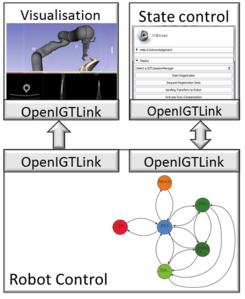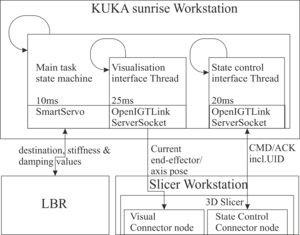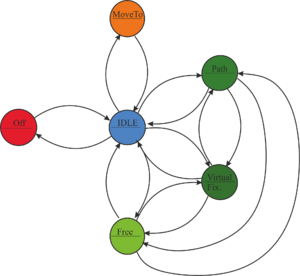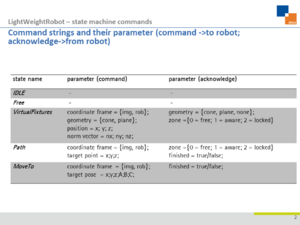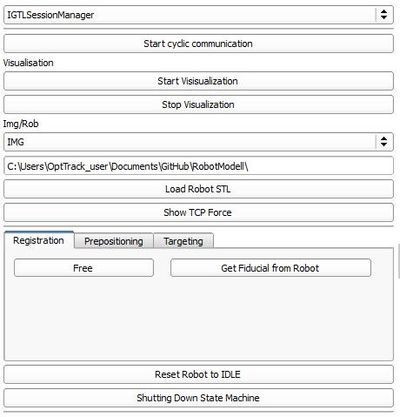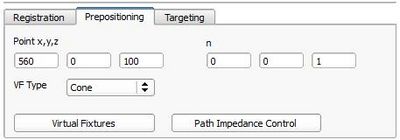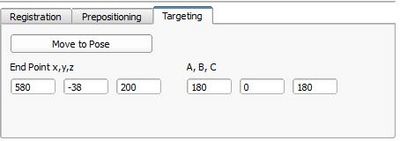Difference between revisions of "Documentation/Nightly/Extensions/LightWeightRobotIGT"
| Line 52: | Line 52: | ||
{{documentation/{{documentation/version}}/module-section|Panels and their use}} | {{documentation/{{documentation/version}}/module-section|Panels and their use}} | ||
{| | {| | ||
| − | |[[Image:Panel.jpg|thumb| | + | |[[Image:Panel.jpg|thumb|400px|LighTWeightRobotIGT]] |
|} | |} | ||
{|style="width: 100%" | {|style="width: 100%" | ||
| | | | ||
| − | *''Start Communication'': Starts the cyclic communication with the state machine on the robot control | + | *''Start Cyclic Communication'': Starts the cyclic communication with the state machine on the robot control |
| − | *''Start Visualisation'': Sends a command to the robot control to activate the | + | *''Start Visualisation'': Sends a command to the robot control to activate the visualization |
| − | *''Stop Visualisation'': Sends a command to the robot control to deactivate the | + | *''Stop Visualisation'': Sends a command to the robot control to deactivate the visualization |
| − | *''Load Robot'': Loads the stl-files of the robot and the tool from the path defined by "Path". | + | *''Img/Rob'': Changes the coordinate frame of the robot pose send from the robot control to image space or robot base frame |
| + | *''Path'': Path were the robot stl files are located | ||
| + | *''Load Robot STL'': Loads the stl-files of the robot and the tool from the path defined by "Path". | ||
*''Show TCP Force'': Visualizing the estimated force at the tool center point by a scaled 3D arrow pointing in force direction. | *''Show TCP Force'': Visualizing the estimated force at the tool center point by a scaled 3D arrow pointing in force direction. | ||
*Registration tab: | *Registration tab: | ||
**''Free'': Sends a transition request to the ''Free'' state to the robot control, in which the robot can be moved freely and manually | **''Free'': Sends a transition request to the ''Free'' state to the robot control, in which the robot can be moved freely and manually | ||
| − | **''Get Fiducial'': Saves the current position in a fiducial list which can be used for a fiducial registration using modul XY | + | **''Get Fiducial from Robot'': Saves the current position in a fiducial list which can be used for a fiducial registration using modul XY |
| align="right"| | | align="right"| | ||
[[Image:PanelPrePositioning.jpg|thumb|400px|Prepositioning tab]] | [[Image:PanelPrePositioning.jpg|thumb|400px|Prepositioning tab]] | ||
| Line 69: | Line 71: | ||
| | | | ||
*Prepositioning tab: | *Prepositioning tab: | ||
| + | **''point x,y,z'': Position of the cone tip or the plane in robot base coordinate frame | ||
| + | **''n'': z-axis of the cone or norm vector of the plane | ||
| + | **''VFtype'': Here you can choose the geometry of the virtual fixture - cone or plane | ||
**''Virtual Fixture'': Sends a transition request to the ''VirtualFixtures'' state to the robot control in which the robot can be moved freely and manually in work space restricted by active constraints. The supported virtual fixtures geometries are ''plane'' and ''cone''. | **''Virtual Fixture'': Sends a transition request to the ''VirtualFixtures'' state to the robot control in which the robot can be moved freely and manually in work space restricted by active constraints. The supported virtual fixtures geometries are ''plane'' and ''cone''. | ||
| − | **'' | + | **''Path Impedence Control'': Sends a transition request to the ''Path'' state to the robot control, in which the robot can be moved on a linear path from the current position towards a target position. |
| align="right"| | | align="right"| | ||
[[Image:PanelTargeting.jpg|thumb|400px|Prepositioning tab]] | [[Image:PanelTargeting.jpg|thumb|400px|Prepositioning tab]] | ||
| Line 76: | Line 81: | ||
| | | | ||
*Targeting: | *Targeting: | ||
| − | **''Move To'': Sends a transition request to the ''MoveTo'' state to the robot control in which the robot moves position controlled towards a target position. | + | **''Move To Pose'': Sends a transition request to the ''MoveTo'' state to the robot control in which the robot moves position controlled towards a target position. |
| + | **''point x, y, z'': Target position in robot base coordinate frame | ||
| + | **''A, B, C'': Euler ankle describing the orientation at the target point in robot b ase coordinate frame of the tool | ||
*''Reset Robot to Idle'': Sends a transition request to the ''Idle'' state to the robot control | *''Reset Robot to Idle'': Sends a transition request to the ''Idle'' state to the robot control | ||
| − | *''Shut Down | + | *''Shut Down State Machine'': Sends a command to shut down the state machine running on the robot control |
|} | |} | ||
Revision as of 16:09, 19 September 2014
Home < Documentation < Nightly < Extensions < LightWeightRobotIGT
|
For the latest Slicer documentation, visit the read-the-docs. |
Introduction and Acknowledgements
|
This work is supported in part by the National Institute of Health (R01CA111288, P01CA067165, P41RR019703,P41EB015898, R01CA124377, R01CA138586, R42CA137886, and
U54EB005 149) and is funded by KUKA Laboratories GmbH (Augsburg, Germany).
Module DescriptionThe LightWeightRobotIGT module allows to communicate with a light weight robot (LWR iiwa, KUKA Laboratories GmbH, Germany, Augsburg) using an open interface concept based on the OpenIGTLink protocol (LWROpenIGTIF). Therefore, a state machine example is available at Git Hub containing the necessary interface classes for the communication on the robot control. A tutorial on how to set up the robotic system for the use with this 3D Slicer module see LightWeightRobotIGT Getting Started. For an introduction of the interface concept see LightWeightRobotIGT Introduction. The module provides the following features:
Use CasesN/A Tutorials
Panels and their use
Similar ModulesN/A References
Information for Developers
|
